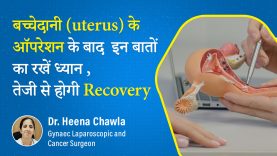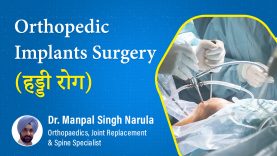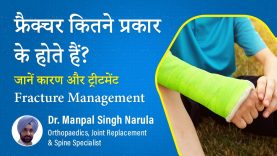Fracture Plaster Types | आधुनिक तकनीक वाले फ्रैक्चर प्लास्टर के प्रकार | Fracture Management
- 1.54K
- 3 years ago
Dr. Manpal Singh Narula
Dr. Manpal Singh Narula
Fracture Plaster Types | Everything about fracture(फ्रैक्चर) management
Fracture plaster types, In this video SimpliHealth expert Orthopaedic and Spine Specialist Dr. MS Narula is talking about fracture(फ्रैक्चर) management. Also he is answering some questions like:
- What is the treatment of different orthopedic fractures?
- What are the latest advancements to manage fractures?
As you know, in earlier days, experts put the fractures together with plaster or with the help of traction. With the advancement in orthopedic practices, we gradually inclined towards surgery. So many advances have come from the last few years, making orthopedic surgery more quick, with remarkable recovery, bloodless, painless, and minimal invasive. I would say we make a minimal incision. With the help of new techniques and better implants, the patients recover fast. It’s painless, and the patient’s joint function is much better. Today we will talk about this a little.
Fracture Management by Plaster
Among various ways of fracture management, plaster is the most common. We apply the plaster with little stretching; which is a standard OPD procedure. We opt for plasters when the fracture is not well-displaced. If it is a minor fracture, we need to plaster for one to one-half months, or there are some small bones, or else I said earlier that the fracture does not move much from its place.
What are the advantages of new plaster?
But nowadays, very good modifications have come in plaster too,we now have lightweight plaster, which has fiber cast. The plaster used in old times caused allergies, sweating, it was heavy, gets wet, and breaks easily. So to bypass all this, we have a lightweight fibre cast that comes in many colors. But, as you must have seen, it is available in blue or pink. That plaster is tough enough so that if we apply it on the foot or ankle, it won’t break even if the patient puts some weight on it. It doesn’t get wet easily and has no issues with skin. So this is one of the advancements in fracture management as far as plaster is concerned.
So the advancement among fractures is that earlier, the lightweight cast replaced the heavy white cast, which we used earlier times.
Cast Bracing Method of Plastering
Now we have another cast bracing method in which we use special braces, made of plastic material and are removable. When we strap them on, they are hinges inside, which helps the joints move. And they can be loose or removed for a short time to allow the skin to breathe. So this, too, is a small indication that, unlike previously used plasters, it doesn’t allow stiffness in the joints and doesn’t lead to any skin issues. And the latest that has come is the breathable plaster on which there is mesh-like material inside, you can observe the skin for any rashes, and we can do an X-ray on the same plaster.
So all the previous issues of plaster-like skin rashes or joint stiffness have been sorted. With the new technique, the plaster is easy to apply, remove, and convenient for the patients.
So, as I said in previous times, more emphasis was on staying on the bed, not moving their limb, which usually leads to stiffness in joints or muscle atrophy. But nowadays, emphasis is made on the fact that the patient stands as early as possible, his joints are mobile, and can restore the patient’s limb function.
These days, we treat most of the fractures by operative management, especially those displaced from their original position or are complicated or comminuted, or are multiple fractures. Our emphasis is to fix it as early as possible so that the patient can use their arms or legs or fracture body parts. There have been newer advances, so first, I would like to talk about the advancement in operation theatre where we perform all the orthopedic surgeries.















Comments (0)